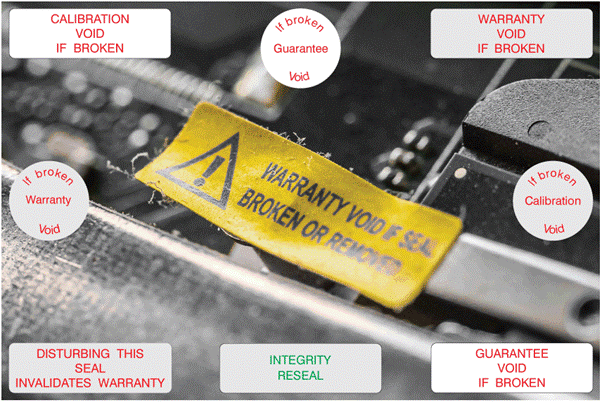
If you've ever opened up a laptop for repair, looked on the side of a desktop computer, or looked inside a smart phone, you may have seen a "warranty void if removed" label. Did that stop you from fiddling with the insides, or did you just ignore it and carry on whatever upkeep or improvement you had planned?
Let’s take a look at what exactly warranty labels are and the legalities surrounding them.
What is a Warranty Sticker?
Warranty labels are used to protect a brand's range and to make sure that everyone behaves in accordance with the product’s instructions. Breakaway labels and void labels are the 2 types of warranty labels that are offered.
- Breakaway label - It is impossible to remove breakaway labels without damaging them. They are formed out of a material that has been specially created.
- Void label- Void labels are tamper-evident labels. A void label will leave a void text mark if you attempt to remove it, indicating that it has been tampered with.
The purpose of a void label is for manufacturers and sellers to be able to tell when a product has been tampered with. If an attempt at removing a warranty label has been made in any way, a manufacturer may be able to class the product’s warranty as void.
Are ‘Warranty Void if Removed’ Labels Legal?
In the US, the Federal Trade Commission (FTC) says no. The federal law that oversees consumer product warranties was approved by Congress in 1975 and is known as the Magnuson-Moss Warranty Act. The Act mandates that merchants and producers of consumer goods give consumers clear, comprehensive information about warranty coverage. It has an impact on consumer rights and warrantors' obligations under written warranties. Although the Act makes it simpler for customers to file a lawsuit for warranty breach, it also informally encourages amicable disputes.
Unfortunately, things are a bit more complicated here in the UK.
Warranty Law in the UK
Although conditions are a little more difficult in the UK, we are mostly protected from defective products, whether they are under warranty or not, thanks to the European Union (EU). A manufacturer is required by EU law to provide free repair or replacement for the first two years of ownership of a defective good. If they are unable to do so, they must issue a full or partial refund.
There are concerns with specific warranty issues. A manufacturer does have the option to decline a repair in the UK and throughout Europe if it thinks the warranty has been void. Even if there is a known defect with the product or if the third-party repair, which voids the warranty, had nothing to do with the issue at hand, many manufacturers will nevertheless fix the item.
In the UK, however, stickers cannot void a six-year legal guarantee after the time of purchase.
Sales of Goods Act
You can still use your statutory rights under the Sale of Goods Act if a manufacturer refuses to work on your equipment because it is past the warranty period, even though you are aware that the problem was not your fault.
This implies that you can ask for a refund or replacement directly from the vendor from whom you purchased your equipment.
Unfortunately, even this isn't exactly clear-cut. A store has the authority to demand proof that the equipment has a manufacturing defect and that your damage to it did not cause it to break.
Keep to Good Practice Procedures with Label Source
Here at Label Source, we offer a wide variety of quality control and calibration labels for use within ISO 9001 quality schemes and good practice procedures within the UK, Europe, and beyond.
Our range includes calibration labels, inspection tags, production status signs, and many other products.